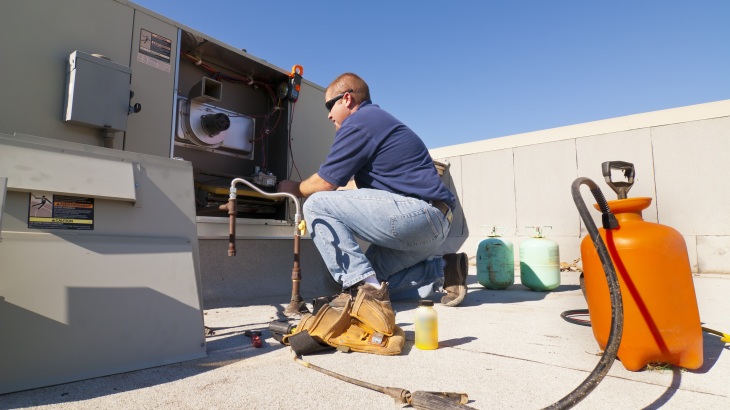There are signs that let you know if you have an energy inefficient HVAC. Some of these are noticeable, and some require a bit of analysis. In many cases, a solution is a simple repair or filter replacement. In this article, we will share some things to look out for to determine if you have an energy inefficient HVAC.
#1. Your HVAC is 10 years or older
According to Energy.gov, HVAC systems have a lifespan of about 15-20 years. Yet, HVAC systems only run efficiently for about 10 years. Newer, more efficient HVAC systems can save between 20-40%. Not to mention, 10 years will put a lot of wear and tear on your system that could lead to very expensive maintenance or repair costs if they break down. If you have an HVAC system over ten-years-old, ask a professional for advice on the best route to take to avoid major problems down the road.
#2. Your System Needs New Air Filters
Filter replacements is one of the easiest and inexpensive solutions to keeping your HVAC efficient. If left unchecked, however, dirty air filters can cause energy inefficiency and potential health risks. Let’s discuss what kind of energy inefficiency and problems are caused due to dirty air filters.
Health Risks
Mold, dust, bacteria, gasses, and other particles can be transmitted through the air by a poorly maintained or dirty HVAC system, which can cause employees to have allergic reactions, have asthma, or experience other health issues. Mold, in particular, is always a main cause for concern. Mold will appear in all HVAC systems unless maintained properly, as it lives within environments with excess moisture, which means your HVAC’s ducts, coils, and drip pans.
Higher Operating Costs
According to the EPA, dirty air filters attribute to an extra 15% in electricity costs. Air filters allow for proper airflow throughout the ducts. Poor airflow means the system will have to run longer to produce the right amount of air circulation throughout the building, increasing overall costs. When to change your filter depends on how dirty the air is and how big the filter is, but it is recommended they are replaced at least every six months.
Dirty Coils
If your HVAC has dirty air filters, you will likely have dirty coils. You may also get dirty coils if you run your system without an air filter because all of the dust, particles, and other bacteria will attach itself directly to your coils instead of the filter.
There are two types of coils in your HVAC system: a condenser and evaporator. Your HVAC heats or cools buildings, depending on your thermostat settings, and the coils are what increase or decrease the temperature. When your coils are dirty, their functionality decreases. Here’s some of the issues that are caused by dirty coils.
An energy inefficient HVAC will cool only at 60 or 70% of its effectiveness
HVAC lifespan decreases significantly
#3. Noticeably Higher Energy Costs
Proper maintenance on HVAC systems is not as common as you may think. HVACs run in the background, and if everything is operating normally, most office staff doesn’t think twice about it. By the time there is a noticeable problem, it will often result in a costly repair. If you start seeing higher energy bills, and your business hasn’t made any significant routine changes, an improperly maintained HVAC could be the issue.
Dirty Ducts
Dirty ducts are the result of dirty air filters. When your ducts are dirty or clogged with excess particles, it prohibits the airflow, making your system work harder than necessary. Unless the problem is serious, you’ll see a rise in your electricity bill since your HVAC will still provide the required heating and cooling comfort levels, but use more energy to do it.
Chillers
Chillers are among the largest single energy users in HVAC systems, often accounting for 50% of total HVAC electricity cost. In the simplest explanation, a chiller works to remove heat to produce cooler temperatures (air conditioning). Improper maintenance can cause chillers to get clogs or damaged tubes and leaks, which can lead to a 10% increase on your electricity bill. One way to improve a chiller’s efficiency is to install a variable speed drive (VSD). A VSD calculates the required load demand the HVAC needs to cool a building properly and matches the motor speed to that demand to reduce energy and improve efficiency. Variable speed drives are important for enhancing chiller reliability and lifespan.
Disabled Dampers
Dampers can get lodged in an open position causing heating coils in the air duct to work harder than necessary. Just like with dirty ducts, this often goes unnoticed because comfort levels will not decrease, as the HVAC will still maintain the appropriate comfort levels, but at a higher energy expense.
Duct Leakage
Duct leakage can account for 20-40% energy loss, even in a well-operated system. This can also cause inconsistent heating and cooling throughout the building.
Reduce Load Capacity
Reducing load capacity helps your HVAC system run less frequently. Installing insulation, energy-efficient windows, window film, energy-efficient lighting, and upgrading to ENERGY STAR certified office equipment are measures to help reduce load capacity. Please see our article 7 Easy Tips to Improve Your HVAC Efficiency for more information.
#4. Your HVAC Needs Frequent Repairs
There’s no point to keep dishing out money for repairs for a system that keeps breaking down. HVAC systems that fail continuously are not only bad from an economic standpoint, but they could be dangerously unhealthy (see #2). HVACs that are either too old or are costing too much money in electricity costs and repairs should be replaced.
Bottom Line
HVACs are a large capital investment for many businesses. It is important to keep them maintained and clean in order to maximize efficiency, maintain employee health, and ensure a long HVAC lifespan.
Sources:
HVAC.com: What Are The Effects of Mold in my HVAC System and How do I Know if it Have it?




